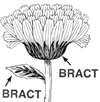Milo
Thespesia populnea
Mallow family (Malvaceae)
Polynesian introduction
Milo is common along shorelines through the islands and is also planted for ornament and shade. It is said to have been introduced by the early Hawaiians. It is recognized by the large bell-shaped flowers, like hibiscus, with five overlapping pale yellow petals, single at leaf bases, by the dark gray, rounded but flattened, hard dry that usually do not split open, and by the long-pointed shiny heart-shaped leaves usually with seven main veins from base.

©2008 Eric Hunt
Leaves with long leaf-stalks of 2–4 inches (5–10 ). Blades heart-shaped, 4–8 inches (10–20 ) long and 2 1⁄2–5 inches (6–13 ) broad, long-pointed, not on edges, slightly thickened and leathery, usually with seven main veins from base, shiny dark green on upper surface, paler beneath, becoming nearly hairless.
Flowers single at leaf bases, opening one at a time, on stout stalks of 1⁄2–2 inches (1.3–5 ). cup shaped, green, about 3⁄8 inch (10 ) high and 1⁄2 inch (13 ) across, remaining at base of with 3–5 narrow green () 1⁄2 inch (13 ) or more in length on outside, falling from bud. Petals five, broad rounded oblique, 2 inches (5 ) or more in length, pale yellow, usually with maroon spot at base, with tiny star-shaped hairs on outer surface. many, on a column 1 inch (2.5 ) long joined at petals at base. has a five-celled with slender and five broader stigmas. Flowers opening and closing the same day, petals withering and turning to purple or pink.
(seed capsules) rounded but flattened, about 1 1⁄4 inches (3 ) in diameter and 3⁄4 inch (2 ) high, slightly five-ridged, dark gray, hard, woody and dry, with at base, usually remaining attached and not splitting open. Seeds are several, elliptical, 3⁄8 inch (1 ) long, brown hairy. Flowering from early spring to late summer.
The beautiful wood of milo, with light brown sapwood and reddish brown to chocolate brown heartwood, takes a fine polish. It is moderately heavy ( gr. 0.6), easy to work, has a low shrinkage in drying and is durable. It is classed as resistant to attack from drywood termites and is used elsewhere in boatbuilding and cabinet work. The Hawaiians carved it into beautiful bowls, such as calabashes for poi. It is presently an important craftwood, used for turned bowls and carved figures (tikis). The wood contains an oil that retards drying of oil-base varnishes but does not affect lacquers.
Elsewhere, rope has been made from the tough fibrous bark. It is reported that flowers and young leaves are mildly poisonous, though they also have been eaten. The seeds have been employed medicinally.
Several milo trees were planted around the house of King Kamehameha at Waikiki. In some Pacific Islands this species was regarded as sacred and was cultivated around temples.
Occasionally planted in the tropics as a street tree and ornamental, it produces dense shade and much leaf litter; it is also used as a living fence. In West Indian islands, where cotton is an important crop, this species is eradicated because it is a host of the cotton stainer, a red insect that stains fibers of growing cotton.
In Hawaii, common along sandy shores and borders of brackish marshes through the islands. Also planted around houses, formerly more than now. A particularly large tree is on the Ward Avenue side of Thomas Square in Honolulu. The trees are hardy in dry coastal areas but more common on windward shores where they are protected by reefs. The rounded but flattened dark brown seed capsules usually present in the upper distinguish milo from hau, Hibiscus tiliaceus, which has elliptical long-pointed gray green seed capsules.
Special areas
Keahua, Waimea Arboretum, Haleakala, City, Volcanoes
Champion
Height 42 ft (12.8 ), c.b.h. 9 ft (2.7 ), spread 69 ft (21 ). Kekaha, Kauai (1968).
Range
Widely distributed on tropical shores throughout the world, native in the Old World. Transported by floating and seeds. Naturalized elsewhere along shores of southern Florida, through West Indies including Puerto Rico and Virgin Islands, and continental tropical America from Mexico to Brazil and Chile.
Other common names
seaside mahoe; emajaguilla, otaheita (Puerto Rico); haitihaiti (Virgin Islands); kilulo (Guam); banalo (N. Marianas); badrirt (Palau); bangbeng (Yap); polo (Truk); pone (Pohnpei); panu (Kosrae); milo (Marshalls, Am. Samoa)
Common names in Puerto Rico and Virgin Islands are derived from Tahiti, a Pacific island where this species is native.
Some dissemination of this species from island to island through the tropics by ocean currents apparently is natural. Seeds in the lightweight can germinate after floating a year in seawater.





